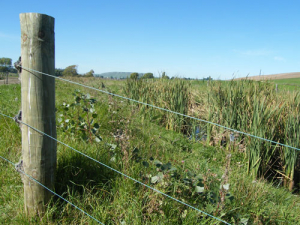MPI launches industry-wide project to manage feral deer
An industry-wide project led by Ministry for Primary Industries (MPI) is underway to deal with the rising number of feral pests, in particular, browsing pests such as deer and pigs.
 New freshwater reforms will result in 56,000 km more fences protecting New Zealand waterways from stock.
New freshwater reforms will result in 56,000 km more fences protecting New Zealand waterways from stock.
New freshwater reforms will result in 56,000 km more fences protecting New Zealand waterways from stock – enough to go round the world one and a half times, says Primary Industries Minister Nathan Guy.
The new rules on stock exclusion are part of the Government’s plans announced today setting a target for 90% of rivers and lakes to be swimmable by 2040.
“Farmers have made huge progress in recent years to improve their environmental practices and this will be another important step forward. Dairy farmers have already voluntarily fenced off over 24,000km of waterways,” says Guy.
“We know that stock standing in or regularly crossing waterways can do significant damage. While dairy farmers have voluntarily fenced off around 96% of their waterways, we want to extend this to other types of farms as well,” says Guy.
The proposed national regulation would ensure that dairy cattle, beef cattle, pigs and deer are kept out of waterways.
He says we need to ensure the changes are practical for farmers, so the exclusions would be implemented in a staged process starting this year through to 2030, depending on the stock type and land slope.
“There are long term benefits for the primary industries and wider economy from these reforms. Overseas markets and consumers increasingly demand a strong environmental performance over and above regulatory requirements. In this context, protecting New Zealand’s natural advantage has never been more important.
“No single organisation or group is solely responsible for improving our water quality. Meeting the target will take a collective effort, but the primary industries have a key contribution to make.”
In the meantime, the Ministry for Primary Industries continues to work with the primary sectors to invest in good ideas which promote environmental best practice. One example is the Farm Systems Change program, which identifies high preforming farms and uses farmers’ networks to spread their knowledge.
Another is a major programme under the Primary Growth Partnership, called Transforming the Dairy Value Chain. Under this programme effluent management systems have been improved, and every region now has a riparian planting guideline developed in conjunction with regional councils.
Fonterra chair Peter McBride says the divestment of Mainland Group is their last significant asset sale and signals the end of structural changes.
Thirty years ago, as a young sharemilker, former Waikato farmer Snow Chubb realised he was bucking a trend when he started planting trees to provide shade for his cows, but he knew the animals would appreciate what he was doing.
Virtual fencing and herding systems supplier, Halter is welcoming a decision by the Victorian Government to allow farmers in the state to use the technology.
DairyNZ’s latest Econ Tracker update shows most farms will still finish the season in a positive position, although the gap has narrowed compared with early season expectations.
New Zealand’s national lamb crop for the 2025–26 season is estimated at 19.66 million head, a lift of one percent (or 188,000 more lambs) on last season, according to Beef + Lamb New Zealand’s (B+LNZ) latest Lamb Crop report.
Farmers appear to be cautiously welcoming the Government’s plan to reform local government, according to Ag First chief executive, James Allen.

OPINION: Your old mate welcomes the proposed changes to local government but notes it drew responses that ranged from the reasonable…
OPINION: A press release from the oxygen thieves running the hot air symposium on climate change, known as COP30, grabbed your…